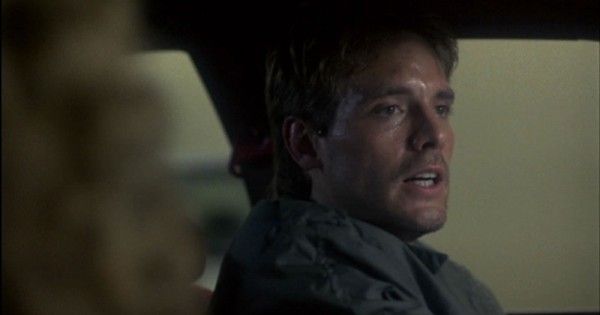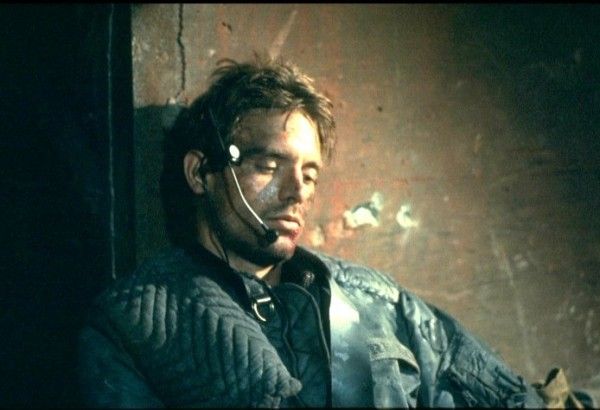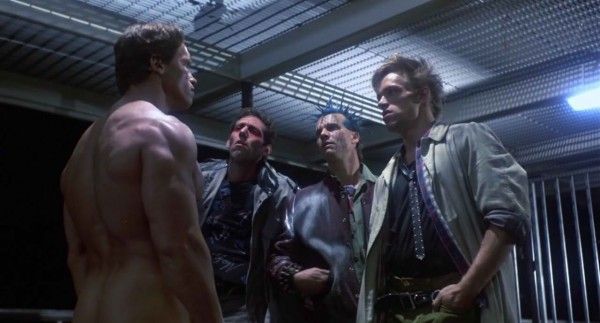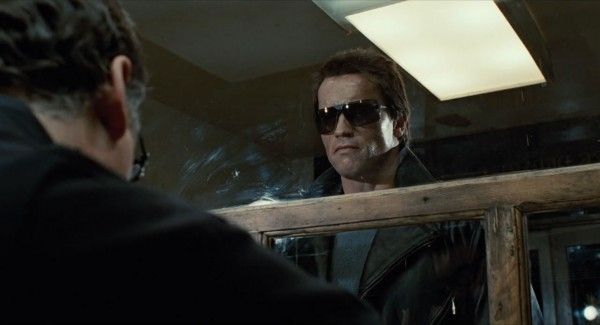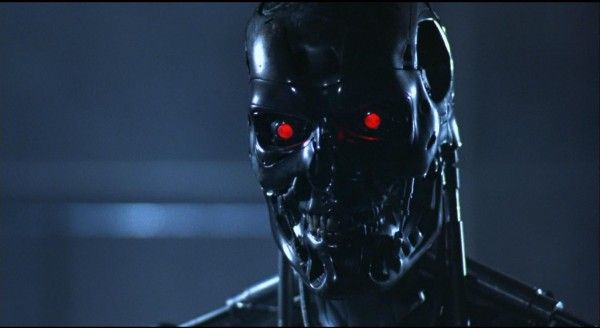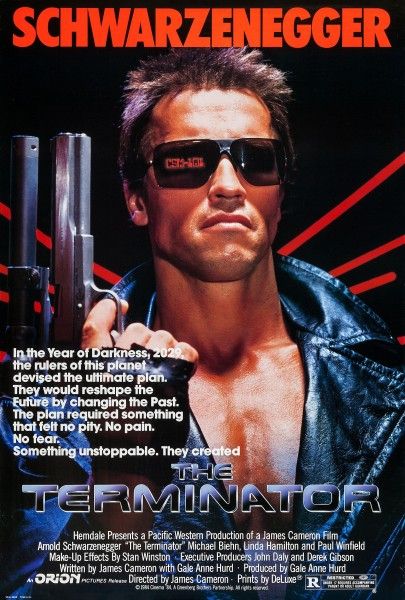There’s no understating the importance of The Terminator when it comes to Hollywood action films. While Terminator 2 has more bells and whistles with regards to visual effects, and is undoubtedly a terrific film in its own right, James Cameron’s 1984 film is a crucial step in the director’s career, Arnold Schwarzenegger’s growth as an actor, and the genre as a whole. The movie blended apocalyptic sci-fi with a hard-boiled action movie that still managed to deliver thrills and emotional investment despite a lack of liquid metal or a surrogate father story. It’s so much more than “I’ll be back.”
In 2029 A.D., machines have risen up to crush humanity, and they have a plan to defeat mankind’s savior, John Connor. They’ve sent a Terminator (Schwarzenegger) back to the year 1984 to kill John’s mother, Sarah (Linda Hamilton), although the only information he has is her name and city, so he (I know it’s a machine, but for clarity I’m using the male pronoun) must utilize the awesome power of a phone book to track her down. Kyle Reese (Michael Biehn), a member of the resistance, follows the Terminator back in time to protect Sarah so that John Connor can be born.
Think about that for a moment: Kyle Reese, ostensibly the film’s “hero”, is sent through time not to stop the rise of the machines, but to save Sarah Connor so that when the apocalypse does come, humanity will have its champion.
The Terminator is drenched in fatalism. Reese’s description of the Terminator, specifically the new T-800 model that’s a metal endoskeleton with real flesh grafted on, is chilling:
“It can’t be bargained with. It can't be reasoned with. It doesn't feel pity or remorse or fear. And it absolutely will not stop, ever, until you are dead.”
There will be a future full of these things, and there’s no stopping the nuclear war that will herald mankind’s downfall.
The fatalism of the future comes to the past, and we’re told this straight from the opening titles: “The final battle would not be fought in the future. It would be fought here, in our present.” Enter The Terminator and Reese, and we’re already screwed. Like most wars, it doesn’t stay contained to a single battlefield, but rather than crossing into new territories, the war against the machine crosses across time.
When The Terminator cuts to the future, Cameron almost gives us whiplash. The battles are big, yet cramped and abrupt, almost as if the director is telling us, “This is what I’d like to do more of, but there’s a budget to consider.” No offense to Piranha Part Two: The Spawning [a movie where Cameron was basically a hired gun, and was even locked out the editing room], but The Terminator is Cameron’s first real movie, and he’s swinging for the fences when it comes to the special effects. While Reese’s flashbacks to the future tell us more about his world, Cameron already told us everything we need to know in the first 10 minutes of the movie.
One of the first images is from the post-apocalyptic future and shows a tank rolling over human skulls—a machine crushing anything that’s underfoot, a visual motif that Cameron employs multiple times throughout the film. Then the director drops in the T-800 and Reese shortly after and we quickly know the stakes.
The T-800 lands perfectly, rises slowly, and even though he’s naked, he shows no hesitance. He looks out over L.A. and already owns the city. He then kills a couple people so he can take their clothes (to be fair, he did ask first), and goes off into the night with his single mission. It’s one hell of an introduction that utilizes Schwarzenegger’s pure physicality for his second major role (Conan the Barbarian being the first).
Then we move to Kyle Reese, who is basically dropped out in the fetal position and has to scurry away from the cops after stealing pants from a homeless man. Biehn plays the role as lean, frantic, and borderline crazy. It’s pretty much the exact opposite of his performance as Hicks in Aliens, and it works perfectly because the entire movie is a desperate struggle against an unstoppable force.
That’s why the future scenes never work as well as the ones in the present. We can see laser cannons blow people apart, but the machines are a faceless foe, and Reese is only one soldier in a world war. Now he’s on a solo mission against something he’s not even sure can be killed, and it’s only the fate of the world on the line, so no big deal.
Except Reese isn’t the hero. If the objective of the mission is to stop the Terminator and save Sarah Connor, he ultimately does neither. Furthermore, the arc of the film isn’t to stop Judgment Day, which is accepted as inevitable. The arc is to take Sarah Connor—a beleaguered waitress who wears a pink backpack and drives a scooter to work—and transform her into not only the mother of humanity’s savior, but also the person who teaches John that he can become that person. Furthermore, she does this not because Reese teaches her to survive or gives her any formal training. He keeps her alive long enough so she can start her true journey, and that journey doesn’t begin until she terminates the Terminator.
Reese also has a third objective: father John Connor, which pulls the movie into an odd kind of Christ narrative. John Connor basically facilitated his own birth. He sent his own father back in time so that he could impregnate Sarah Connor, thus giving birth to John Connor. If we want to break out of the crazy time loop, the beginning must have been when another man impregnated Sarah Connor, but that doesn’t really matter. What’s important is that humanity’s savior, who also happens to have the initials “J.C.”, has played a part in an odd kind of Immaculate Conception. The weird twist on the Christ story is the “What if a killer cyborg from the future came to kill Mary?”
This subtext plays beneath a hardcore action film that also undermines the hero narrative by having not only the “damsel” save the day (or at least herself), but also having the villain be the most compelling character. How many movies can you think of where the villain—a character who kills without remorse and only has a handful of lines—is the title character, is the only one on the poster, and the actor has sole billing? Schwarzenegger is truly the star, and it’s not difficult to see why this movie launched both him and the character to iconic status.
Beyond the performances and the characters, The Terminator is a delightfully dark, deeply fucked up movie. Aside from the Terminator coming to perform a “retroactive abortion”, there are home invasions where he kills everyone include a mother of two and he shoots up a police station. And we love him.
The film has a dark fetish about how even though machines are going to kill us, they’re incredibly cool and we constantly depend on them. Cameron is by no means a technophobe, but the Terminator is a twisted being not because of his personality, but because of his construction. Aside from the unforgettable design for the endoskeleton (including human teeth is the stroke of genius), the Terminator is human flesh melded with cold technology, and it yields a heartless monster. But unlike other movie monsters, we don’t identify with the Terminator. We simply relish in the violence he wreaks.
There’s purity in that approach, and Cameron mainlined that action into our veins to the point where any interruption causes withdrawal. Every time Reese has to deliver exposition, or the Terminator is repairing itself, or arrive at the awkward-but-necessary sex scene between Reese and Sarah, we crave death and destruction. We want Sarah to win, but we also love seeing the T-800 at work. And that’s where The Terminator leaves its mark—putting a heart of darkness inside an action thrill ride.
The attitude of The Terminator left its mark on the action genre by pummeling the audience with unique lead characters in a desperate situation drenched in fatalism. It set Schwarzenegger’s career on a path where he would play the unstoppable force of nature. And it was the breakthrough movie for Cameron that allowed him to start delving into bigger, more complex visual effects. The Terminator wasn’t a prelude, but it did set the foundation for everything to move forward—bigger, faster-paced action; Schwarzenegger reframing his character into a hero; and Cameron making another leap forward with effects-driven movies.
“I’ll be back,” stopped being a threat. It became a promise.
Tomorrow: Terminator 2: Judgment Day
Correction: I referred to the Terminator as the T-101, and it's actually the T-800 Model 101, or "T-800" for short. I've updated the article accordingly.


